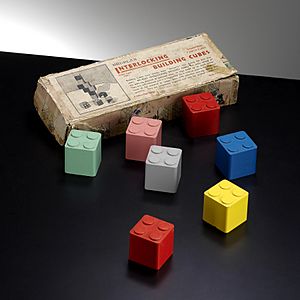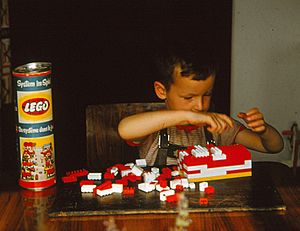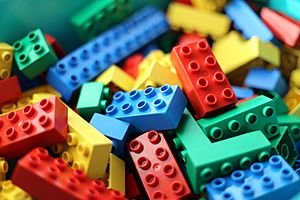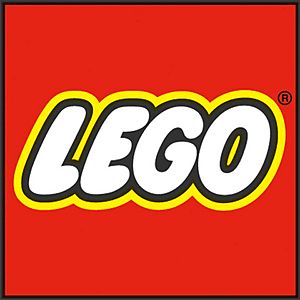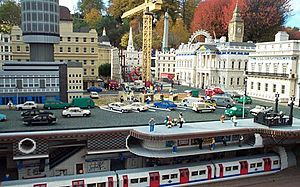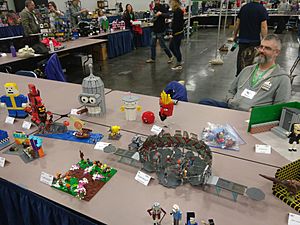History of Lego facts for kids
Lego started in 1932 in the carpentry workshop of Ole Kirk Christiansen. He was a furniture maker from Denmark. During a tough economic time called the Great Depression, he began making small versions of his products. This gave him the idea to create toys. In 1934, his company was named "LEGO." This name comes from the Danish phrase "leg Godt," which means "play well."
After World War II, in 1947, a new way of making plastic items called injection molding came to Denmark. Christiansen bought a machine for this. That same year, he and his son found some plastic, interlocking Kiddicraft bricks. These inspired the first Lego brick, which was created in 1936. The Lego bricks we know today, with hollow tubes underneath for stronger connections, were patented in 1958. Over many years, the Lego system changed and grew with new shapes and colors.
Today, Lego is a very successful brand. It offers building kits and many other fun products and services. These include Lego board games, stores, video games, movies, theme parks, and even consulting. Even with all its growth, the company is still owned by the same family. Lego has had a big impact on many parts of popular culture around the world.
Contents
How Lego Started (1932–1959)
The Lego Group began in a workshop owned by Ole Kirk Christiansen. This was in Billund, Denmark. He bought the woodworking shop in 1916. At first, he and his team built houses and furniture. After a fire in 1924, Christiansen built a bigger workshop. However, the Great Depression meant fewer customers. He had to find new ways to make money. He started making tiny versions of his furniture, like small stepladders. These small models gave him the idea to make toys.
On August 10, 1932, Christiansen started making wooden toys. These included piggy banks, pull toys, and small vehicles. Because of the difficult economy, the business often struggled. Sometimes, he even accepted food from farmers as payment. He kept making furniture alongside toys to keep the business going. His son, Godtfred, joined the company around this time.
In 1934, Christiansen asked his staff to suggest names for the company. He chose "Lego," which comes from the Danish words leg godt, meaning "play well." Later, the Lego Group found out that "Lego" also means "I put together" in Latin.
After World War II, plastic became available in Denmark. Lego bought a plastic injection molding machine in 1947. One of the first plastic toys was a truck that could be taken apart and put back together. In 1947, Ole Kirk and Godtfred saw some interlocking plastic bricks made by a company called Kiddicraft. These "Kiddicraft Self-Locking Building Bricks" were designed by Hilary Fisher Page.
In 1949, the Lego Group started making similar bricks. They called them "Automatic Binding Bricks." These early Lego bricks were made from cellulose acetate. They were like wooden blocks that could stack, but they also "locked" together. They had round "studs" on top and a hollow bottom. They held together well but could still be pulled apart. In 1953, the bricks were renamed Lego Mursten, or "Lego Bricks."
In the 1950s, Lego began selling its products in other countries. They first focused on countries in Northern Europe. In 1954, Godtfred Kirk Christiansen became a junior manager. He had an idea for a "toy system" after talking with a buyer. This meant having many related toys that worked together. He saw the plastic bricks as the best choice for this system. At first, customers did not like plastic toys as much as wooden or metal ones. Many Lego shipments were returned because of low sales. In 1955, Lego released the "Town Plan" using its plastic building bricks.
The first building bricks had a limited ability to lock together. This changed in 1958 when hollow tubes were added to the underside of the bricks. This new design made the bricks much stronger and allowed for many more building possibilities. The company patented this new design. Also in 1958, Ole Kirk Christiansen passed away, and Godtfred took over as the company's leader.
The Shift to Plastic Bricks (1960–1969)
In 1960, a fire destroyed most of Lego's wooden toy stock. This led Godtfred to stop making wooden toys completely. His brothers, Gerhardt and Karl Georg, then left Lego to start their own company, Bilofix. By the end of that year, the Lego Group had over 500 employees.
In 1961, Lego wanted to sell its products in North America. They partnered with Samsonite to produce and sell Lego toys in the United States and Canada. In 1961 and 1962, the first Lego wheels were introduced. This allowed children to build cars, trucks, and other vehicles. During this time, Lego also started making toys specifically for very young children.
In 1963, the material used for Lego bricks, cellulose acetate, was changed. It was replaced with a more stable plastic called acrylonitrile butadiene styrene (ABS plastic). This is the same plastic used today. ABS is safe, does not easily change color or shape, and resists heat and chemicals. In 1964, instruction manuals were included in Lego sets for the first time.
A famous Lego series, the Lego train system, was released in 1966. The first train sets included a 4.5-volt motor, a battery box, and rails. A 12-volt version was released two years later.
On June 7, 1968, the first Legoland Park opened in Billund. It featured amazing miniature towns built entirely from Lego bricks. This theme park attracted 625,000 visitors in its first year. Over the next 20 years, the park grew much larger. Sales of Lego sets also reached over 18 million units in 1968.
In 1969, the Duplo system was introduced. Duplo bricks are much larger than regular Lego bricks. This makes them safer for younger children. However, the two systems work together: Lego bricks can fit onto Duplo bricks. This allows children to easily move from Duplo to Lego as they grow older. The name Duplo comes from the Latin word duplus, meaning "double." A Duplo brick is exactly twice the size of a Lego brick in every direction.
Growing and Innovating (1970–1991)
During the last three decades of the 20th century, Lego explored new areas of toy making. In 1971, the company started making toys for girls. They introduced furniture and dollhouses under the Lego Homemaker theme. In 1972, Lego added boat and ship sets with floating hull pieces. Godtfred Kirk Christiansen's son, Kjeld Kirk Kristiansen, joined the management team that year. He helped set up new factories and a research department.
In 1972, the LEGO logo was updated. The square shape stayed, but the word "system" and the colored stripes were removed. The letters became sharper, with a black and yellow outline. In 1974, human figures with movable arms appeared in "Lego family" sets. These became very popular. The next year, a simpler version of the "minifigure" was introduced. It was not posable and had no face printed on its head. That same year, Lego opened its first North American factory in Enfield, Connecticut, United States.
In 1975, "Expert Series" sets were released for older, more experienced builders. These were followed by "Expert Builder" sets in 1977. These technical sets had moving parts like gears, differentials, and axles. They allowed builders to create realistic models, such as cars with working steering. In August 1978, the famous Lego "mini-figure" was added. These small Lego people had posable arms and legs. They usually had a simple smiling face. The minifigure was used in many Lego sets, creating towns filled with happy Lego citizens. Lego also explored space with Lego Space sets, featuring astronaut minifigures and rockets. They also went back in time with the Castle theme.
In 1979, Lego introduced the Scala series, which included jewelry items for young girls. Kjeld Kirk Kristiansen also became the president of Lego that year.
Teachers had long seen how Lego bricks could help children learn and solve problems. In 1980, the Lego Group created the Educational Products Department. This department, later called Lego Dacta, aimed to expand the educational uses of their toys. New factories opened in Switzerland and Jutland, Denmark, where Lego tires were made.
Between the 1960s and 1990s, Lego partnered with Royal Dutch Shell. This allowed Shell's logo to appear on some Lego items.
In 1981, the second generation of Lego trains arrived. These trains were available in 4.5 V (battery-powered) or 12 V (mains powered). They came with many more accessories, like working lights and remote-controlled signals.
The "Expert Builder" series became the "Technic" series in 1982. On August 13 of that year, the Lego Group celebrated its 50th anniversary. A book called 50 Years of Play was published. The next year, the Duplo system added sets for even younger children, including infants. These new sets had baby rattles and figures with movable limbs. In 1984, Lego minifigure citizens gained a world of knights and horses with a redesigned Castle theme. Light & Sound sets appeared in 1985. These sets included a battery pack with lights and buzzers. This added more realism to Lego creations. Also that year, Lego's educational division created the Technic Computer Control. This system allowed computers to control Technic robots and other models. A Lego factory also opened in Manaus, Brazil.
In 1984, the Technic line grew with the addition of pneumatic components. These parts used air pressure to create movement.
In August 1988, 38 children from 17 countries took part in the first Lego World Cup building contest in Billund. That same year, Lego Canada was established. The Lego line grew again in 1989 with the release of the Lego Pirates theme. This theme featured pirate ships, deserted islands, and treasure. The Lego Group's Educational Products Department was renamed Lego Dacta. This name comes from the Greek word "didactic," meaning "the study of learning." Dr. Seymour Papert from MIT, who linked the Logo programming language with Lego, was named "Lego Professor of Learning Research."
Until 1989, Lego minifigures only had yellow skin color and a standard smiling face. That year, the Lego Group added more facial expressions. These included beards, eye patches, sunglasses, and lipstick. These new faces were mostly for the minifigures in the new Lego Pirates theme. They also appeared in Lego Castle, Lego City, and Lego Space sets. Some older collectors preferred the simpler faces. However, these more detailed faces helped create unique characters with their own stories.
In 1990, Lego released a new series for advanced builders called Model Team. These sets, like a race car and an off-road vehicle, had amazing detail and realism. While Technic focused on how things worked, Model Team focused on how they looked. The Lego Group became one of the top 10 toy companies that year. It was the only European toy company in the top 10. Also in 1990, Legoland Billund welcomed over one million visitors for the first time. Lego Malaysia was also established. In 1991, Lego Group standardized its electrical parts. Train and Technic motors became 9V to match other Lego products.
In 1992, two Guinness records were set with Lego. A castle made from 400,000 Lego bricks was built on Swedish television. It measured 4.45 meters by 5.22 meters. Also, a 545-meter-long Lego railway line with three locomotives was built. Duplo added the Toolo line, which included a screwdriver, wrench, nuts, and bolts. The Paradisa line, for girls, brought new pastel colors to Lego. It focused on leisure resorts, horses, and beach life. In 1993, a Duplo train and a parrot-shaped "brickvac" (a vacuum for Lego pieces) were released.
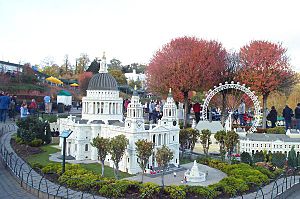
In the late 1990s, the Lego Group introduced new and specialized lines for different groups. The Slizers/Throwbots line used Technic pieces to create action figures for boys. Belville was a more traditional line for girls, with large posable figures. "Lego 4 Juniors" featured medium-sized figures without jointed arms. In 2003, Lego launched Clikits, a system for girls to make customizable plastic jewelry and accessories. In 2004, Lego added the QUATRO brick for ages 1–3. Like Duplo, a Quatro brick is four times the size of a regular Lego brick and works with Duplo. Also that year, they created the second line of Knights Kingdom themed products.
Facing Challenges (1992–2004)
Lego's profits started to go down after 1992. Around 1995 or 1996, many experienced Lego designers left. They were replaced by new designers who were less familiar with toy design and Lego building. At this time, it took over a year for a new set to go from an idea to store shelves. By 1997, product designs changed. Sets had fewer pieces and were quicker to build, but this was not always popular with long-time Lego fans. The Lego Pirates theme, which had been popular since 1989, ended production in 1997.
On April 1, 1995, Lego's founding family created the Kirkbi investment firm. This firm has since managed The Lego Group.
These changes in design teams made the company's challenges worse. In 1998, Lego reported its first-ever financial loss, losing £23 million. In the same year, the company reduced its staff by 1,000 employees.
In 1999, Lego started making products based on popular movies and characters. These included Lego Star Wars and Winnie the Pooh Duplo. In 2000, Lego Harry Potter characters and figures from Steven Spielberg movies followed. Lego leaders discussed toy weapons, noting that after Lego Star Wars, they became "more comfortable with conflict." They aimed to make any conflict "not explicit, but humoristic." While licensed products gave a short boost to profits when blockbuster movies came out, sales often dropped afterward. Also, the cost of licenses made these sets more expensive, which some long-time fans disliked.
After 1999, many of Lego's own characters became very popular through media and other products. A notable example was Bionicle, which ran from 2001 to 2010 and again in 2016. In 2002, Duplo and Lego Baby were combined into a new brand called Lego Explore.
In 2003, after including Lando Calrissian in a Star Wars set and basketball players in a sports theme, Lego decided something new. Minifigures based on real people or live-action franchises would have natural skin tones.
In 2004, Lego reported a loss of £174 million. The executive vice-president of marketing, Mads Nipper, later said the company was "almost bankrupt" at this point. He explained that Lego kept investing as if it were growing strongly. They did not realize that children's play habits were changing. They were not making toys that were interesting enough and failed to innovate.
In 2004, Kjeld Kirk Kristiansen stepped down as CEO. He appointed Jørgen Vig Knudstorp, the first CEO not from the family. The company sold the four Legoland parks to Merlin Entertainments, a theme-park operator. Also, Lego brought most of its manufacturing back under its own control.
A Strong Comeback (2005–Present)
The company focused on its main products and brought back the Duplo brand in late 2004. Since 2004, manufacturing moved to Mexico, and distribution moved from Billund to the Czech Republic. By 2007, the global staff was reduced from 9,100 in 1998 to 4,200. In the US, Lego sales increased by 32 percent thanks to Star Wars and Indiana Jones-themed games. Globally, 2008 sales increased by 18%. In 2009, Lego Games (board games) and Lego Power Miners were introduced, along with the idea for Lego Ninjago. Even during the Great Recession, profits for 2009 were £99.5 million.
In 2011, Lego launched a new theme called Lego Ninjago, which became popular worldwide. They also renewed a long-term agreement with Royal Dutch Shell. However, Greenpeace raised concerns about this partnership in 2014. After the Greenpeace campaign, Lego decided not to renew the contract. The Shell logo only appeared in sets co-licensed with Ferrari or BMW.
In 2012, an animated short film called The Lego Story was made for Lego's 80th anniversary. It showed the challenges faced by Ole Kirk Christiansen and his son Godtfred from 1932 to 1968 as they built the company.
In 2013, the LEGO Group announced it would build a factory in China. This was part of a plan to have production closer to its main markets. Asia was seen as a key future market due to rising Lego sales there.
In 2014, Warner Bros and The Lego Group released The Lego Movie. This computer-animated adventure comedy told the story of Emmet Brickowski, an ordinary Lego minifigure construction worker. He was predicted to save the world. The film received very positive reviews and had a very successful opening.
In 2015, the Lego company faced a public discussion when it refused a large order from Chinese artist Ai Weiwei. Ai Weiwei had used Lego bricks to create portraits of political activists. Lego stated it would not sell directly to users with "political intentions." This decision sparked debate online, and many Lego fans offered to donate bricks to Ai Weiwei.
In 2017, Warner Bros, DC Entertainment, and The Lego Group released The Lego Batman Movie. This was a spin-off based on one of the main characters from the first Lego movie. Lego also released another animated film based on its Ninjago toy line, called The Lego Ninjago Movie, in 2017.
In the first half of 2017, Lego saw its first drop in revenue in 13 years. In September 2017, the company announced plans to reduce its workforce by 1,400 jobs.
On February 7, 2019, a sequel to The Lego Movie was released by Warner Bros, titled The Lego Movie 2: The Second Part. Many of the original voice actors returned for the sequel. However, it did not sell as many tickets as the first movie.
On November 25, 2019, the Lego Group announced it had bought Bricklink. Bricklink is the world's largest Lego fan community. The purchase was completed before the end of 2019.
In November 2020, Lego announced its largest set to date: a replica of the Colosseum in Rome with 9,036 pieces. This set surpassed the previous record holder, the Millennium Falcon from Star Wars. In 2021, the Titanic model topped this record with 9,090 pieces. In 2022, the Eiffel Tower became the second set to reach 10,000 bricks, with 10,001 pieces. The first was the Lego World map.
In 2023, The LEGO Group announced it would move its U.S. headquarters from Enfield, Connecticut, to Boston, Massachusetts. While Enfield had been the regional home for over 50 years, Lego chose Boston for its future head office in the Americas. The move started in mid-2025 and is planned to be completed by the end of 2026.
See also
- Lego City


